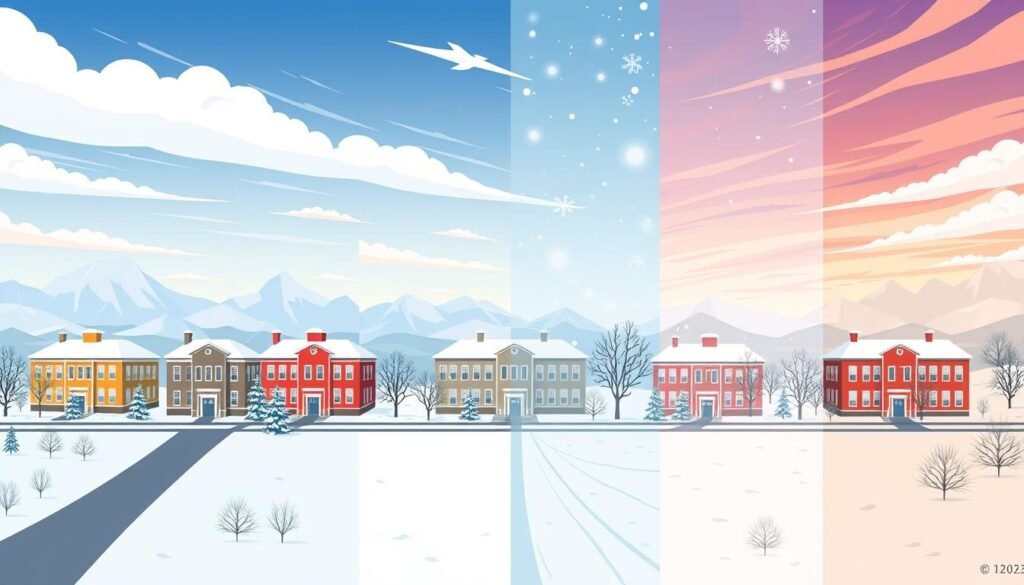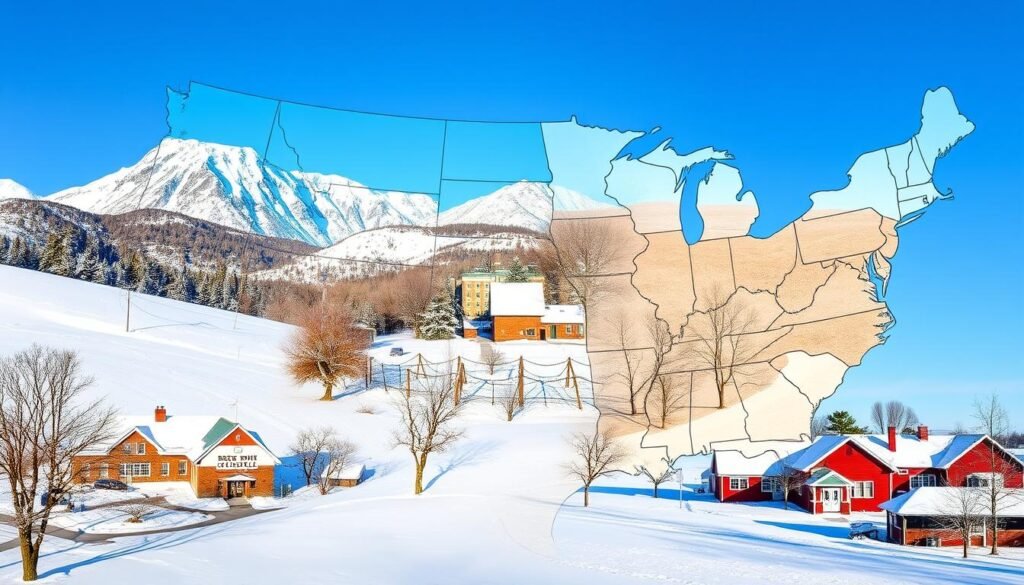Winter is coming, and students are hoping for snow days. These unexpected closures give them a break from school. But how many snow days do schools really get each year? The answer varies a lot depending on where you live in the United States1.
Key Takeaways
- Schools in the northeastern US average 4-6 snow days per year
- Midwest schools see around 6-10 snow days annually
- Southern schools have the fewest at 0-2 snow days per year
- Weather conditions, including temperature and precipitation, are the primary factors determining school closures
- School districts balance educational needs with student and staff safety when making closure decisions
The amount of snow and how severe it is decide how many snow days schools get1. Places like the Northeast and Midwest often get a lot of snow. But the South might only see a little snow or ice a few times a year. This means the number of snow days can be very different in different parts of the country1.
School leaders want to keep students and staff safe while trying not to disrupt learning too much. They watch the weather, road conditions, and school buildings to decide when to close schools1.
Introduction: Snow Days and Their Impact
Snow days can be exciting for students, but they also disrupt school schedules and challenge parents2. These unplanned closures due to winter weather affect learning, activities, and meals for students.
Winter Weather and School Closures
When winter storms hit, schools must close to keep students and staff safe. Weather, road conditions, and staff availability guide these decisions2. Snow days can be tough for families, who may miss school meals and childcare.
Quick Answer: Average Snow Days by Region
The number of snow days varies by location. Schools in the Northeast get 4-6 snow days a year. The Midwest sees 6-10, while the South gets 0-2, and the West/Northwest averages 1-32.
| Region | Average Snow Days Per Year |
|---|---|
| Northeast | 4-6 |
| Midwest | 6-10 |
| South | 0-2 |
| West/Northwest | 1-3 |
These regional snow day differences affect the school year and student learning2.
“Snow days provide students with a chance to recharge, improve mental health, reduce stress, and have more time to balance schoolwork and other activities.”3
Traditional snow days bring joy and a chance for outdoor fun and memories3.
Factors Determining Snow Days for Schools
When deciding on snow days, schools look at many things. Weather, like heavy snow or freezing rain, is key because it makes travel hard4. Also, how clear the roads are matters a lot, as icy roads and poor visibility are unsafe4.
The state of the school’s buildings and parking lots is also important. Schools need to be clear of snow and ice to be safe and work well4. Having enough staff is another big factor, as schools need teachers, administrators, and support staff to run smoothly4.
State or District Policies
State or district rules also affect school closures. Some places have clear rules on when to close schools, based on what they can handle4. For example, in southern states, even a little snow might close schools because of the lack of resources4. But in northern states, schools might stay open even in snow, unless it’s very cold or windy4.
Communication and Forecasting
Decisions on school closures come from weather forecasts and local news4. Officials want to be clear about the risks of closing schools4. Tools like forecast trends help them make better choices4.
Broader Implications
Closing schools can hurt the local economy and make it hard for parents to find childcare4. It can also affect students who rely on school meals4. Schools in different areas face different challenges when they close4.
In short, schools must weigh many factors, like weather, buildings, staff, and rules, when deciding on snow days4. Good communication and forecasting are key to making these tough choices4.

In New York State, schools must be open for 180 days a year5. Most districts have six or seven snow days built into their calendars5. Some might change spring break or other days off if they use too many snow days5.
The Kingston City School District covers a big area, making weather a big challenge5. Schools in the Hudson Valley use many ways to tell families about closures, like websites and text messages5. They always put student safety and learning first when deciding about weather-related closures5.
Changes in Snow Day Trends Over Time
Snow day trends in schools have changed a lot over the years. Better weather forecasting lets schools decide when to close or delay classes. They can predict severe weather well before it hits6. Also, schools have better tools for snow removal, like snowplows and salt spreaders. This makes it easier to keep schools safe, cutting down on snow days6.
Remote learning has become more common, giving schools a way to keep learning going even when it’s snowy. Students can learn from home, avoiding the need for full school closures6. This change helps keep education going, even when the weather is bad.
Improved Weather Forecasting
Thanks to better weather forecasting, schools can plan ahead for snow days. Meteorologists can predict bad weather early, helping schools make smart choices6. This means schools can close or delay classes before the storm arrives, not after.
Better Equipment and Resources for Snow Removal
Having better snow removal tools, like snowplows and salt spreaders, has also changed things. Schools can clear snow and ice faster, keeping places safe for everyone6. This makes it easier to keep schools open, even in big snowstorms.
Flexible School Policies Like Remote Learning
Remote learning has given schools a new way to handle snow days. Instead of closing, students can learn online from home6. This way, learning doesn’t stop just because it’s snowy outside.
| Region | Average Snow Days per Year |
|---|---|
| Northeast | 4-6 |
| Midwest | 6-10 |
| South | 0-2 |
| West/Northwest | 1-3 |

“The National Climate Assessment notes that the North American snow season is shrinking, but climate change doesn’t eliminate snowstorms; it just makes them heavier because of more moisture in the air.”6
As the world changes, so do snow day trends in schools. Schools now use better forecasting, equipment, and remote learning to keep learning going. These changes help make education more consistent, even when it’s snowy.
Regional Differences in Snow Day Trends
The number of snow days schools get can change a lot based on where they are. Places that get a lot of snow often have good plans and resources. This means they close schools less often7. On the other hand, schools in areas that don’t get much snow might close more often7.
Culture and society also play a part in how schools handle snow days. Some areas might choose to be extra safe, while others might be okay with more snow7. This difference in how schools prepare for winter can cause big variations in snow days across the country.
| Region | Average Snow Days per Year |
|---|---|
| Northeast | 4-67 |
| Midwest | 6-107 |
| South | 0-27 |
| West/Northwest | 1-37 |
These differences in snow days are due to many things. These include geographic factors, cultural influences, and winter weather preparedness7. Knowing these differences helps schools and families get ready for winter weather. It ensures they can handle any disruptions well.
How Many Snow Days Do Schools Get by U.S. Region?
Winter weather changes a lot across the United States. This means schools in different areas get different numbers of snow days. Let’s explore how many snow days schools get in various parts of the country8.
Northeast: 4-6 per year
In the Northeast, schools face harsh winters with lots of snow. They usually close for 4-6 snow days each year8. Snowstorms and blizzards are common, so schools put safety first when deciding to close.
Midwest: 6-10 per year
The Midwest gets a lot of snow too. Schools there close for 6-10 snow days on average8. Winter weather can be really bad, so schools watch the weather closely and work with local officials.
South: 0-2 per year
The South has milder weather, so schools there close for snow less often. They usually close for 0-2 snow days a year8. Even a little snow or ice can make roads dangerous, leading to school closures.
West/Northwest: 1-3 per year
In the West and Northwest, schools close for 1-3 snow days a year8. How much snow and how often it happens can vary. Places like the Rocky Mountains get more snow and close schools more often.

Knowing how snow days vary by region helps schools and families plan for winter. It helps them make smart choices about school during snowy weather9.
Making the Most of Snow Days: Tips for Parents
When schools close for snow, parents feel both excitement and stress. Kids love the idea of a day off, but finding childcare and keeping them busy can be tough. But, with some planning and creativity, you can make snow days special for your family10.
Have a Backup Childcare Plan
First, make sure you have a backup plan for childcare10. Choose a trusted neighbor, family member, or babysitter for these days. This way, you can work or take a break while your kids are safe10.
Plan Indoor and Outdoor Activities
Use the snow day to plan fun activities for your kids11. You can do crafts, play board games, or go sledding. Building snow sculptures is also a great idea11. Mix structured fun with free play to boost their creativity11.
Keeping a routine on snow days helps kids adjust back to school11. Try reading, math games, or virtual field trips for learning fun11.

By being proactive, you can turn snow days into great family time and learning experiences10. A bit of planning and a positive outlook can make these breaks special for your kids10.
Factors Beyond Weather: Socioeconomic Considerations
Weather isn’t the only thing that affects school closures. Socioeconomic factors also play a big role. For some kids, school lunch is their only meal. Closing schools for snow could leave them without this vital food source12.
Single-parent households and low-income families face big challenges. They struggle to find childcare or take time off work. This shows why snow day policies need to be more thoughtful, considering the needs of all families12.
Disadvantaged communities are hit hard by school closures. Studies show that age, distance to school, and neighborhood choices affect how kids get to school12. Kids from poorer families or remote areas find it harder to get to school on snow days. This makes the educational gap even wider.
But school closures do more than just lose learning time. They also affect childcare, which is key for many families. This is a big problem for single-parent homes or those struggling financially12.
Policymakers need to think about these issues when deciding to close schools. They must make sure that the effects on poor communities are lessened and that all kids have a fair chance to learn.
| Significant Barriers to Active Transport to School (ATS) According to US Parents | Percentage |
|---|---|
| Distance to school | 61.5% |
| Traffic danger | 30.4% |
| Weather | 18.6% |
The table shows what US parents worry about when it comes to getting their kids to school. Distance, traffic danger, and weather are the main concerns12. These issues, along with the economic struggles many families face, highlight the need for a detailed plan to help disadvantaged communities during snow days.
In conclusion, while weather is important, we can’t ignore the social and economic effects of school closures. School leaders and policymakers must look at the special needs of poor communities. They should make sure that snow days don’t hurt learning chances for any student, no matter their background.
Winter Weather Communication and Decision-Making
Local officials use many sources to decide about school closures in winter13. They work with the National Weather Service and private weather experts14. They also talk to road crews, transport providers, and emergency teams to check travel safety.
It’s important for officials to share how sure they are about weather forecasts14. They think about how bad the weather is and how it might affect students and staff14. They also look at extreme temperatures, dangerous roads, and power outages to decide.
Keeping parents and the community informed is key15. Officials use websites, social media, and messages to share news about school status15. This helps families plan and keeps everyone safe during bad weather.
Deciding to keep schools open or close is a tough choice14. Officials must balance risks and make choices that keep students and staff safe14. They also need to keep the community informed.
Cold Temperatures: A Hidden Danger
Many think snow days are just about snow. But, cold weather can be just as dangerous and might close schools too. The Monticello Central School District, for example, checks the National Weather Service’s guidelines. They decide if wind chills and temperatures are too cold for students and staff16.
Winter Operating Procedures for Schools
Schools work hard to keep students safe in winter. They prepare buses early, check classroom temperatures, and keep indoor activities during recess and physical education16. When it’s cold, schools might delay opening. They quickly tell parents about any changes, helping them plan for their kids’ rides16.
When it’s cold, schools hope to delay opening to improve conditions or make transportation safer16. Quick communication is key during these delays. Schools use instant messaging to keep parents updated16.
The Pikmykid platform helps schools send group dismissal notifications. Teachers can send messages by student, grade, bus, or pickup mode16. Parents get a notification through the Pikmykid app as soon as their child is picked up, giving them peace of mind16.
The Pikmykid platform also lets parents add people to their approved list for pickup. This way, if they can’t pick up their child, someone else can16.
| Benefit | Impact |
|---|---|
| Reduced unnecessary or redundant phone calls to the office | 70% reduction16 |
| Time saved for teachers each day | 15 minutes, totaling 50 hours annually16 |
| Reduction in staff needed to manage dismissal processes | Significant reduction16 |
| Faster and safer pickups for parents | Reduced time spent waiting in the carline16 |
These winter procedures show how schools consider many factors to keep students safe in extreme cold.
Conclusion
This article has looked into what makes schools decide to close for snow days. It covered weather, road safety, staff, and school rules17. It also talked about how snow day trends have changed over time, thanks to better forecasting and remote learning18.
It gave regional snow day averages and tips for parents to enjoy these days off17. It also mentioned how cold weather and money issues play a part in these decisions.
This info aims to help you understand how schools decide to close for snow17. It covers snow day trends, what affects school closures, and how snow days vary by region171819.
By reading this, you’ll see the hard choices schools make to keep students safe and learning during bad weather19. This article is great for parents, teachers, or anyone curious about snow days. It’s a useful guide through the complex world of school closures.
FAQ
How many snow days do schools typically get?
What factors do school administrators consider when deciding to close schools for a snow day?
How have snow day trends changed over the years?
How do regional differences affect snow day policies?
What tips can parents follow to make the most of snow days?
How do socioeconomic factors influence snow day decisions?
Where do local officials get their weather information when making snow day decisions?
How do schools address the danger of cold temperatures during the winter?
Source Links
- Anatomy of a snow day: a guide to winter-weather-related school closings – Monticello Central School District – https://www.monticelloschools.net/about-us/facilities-school-safety/closings-delays/anatomy-of-a-snow-day-a-guide-to-winter-weather-related-school-closings/
- The Beginning of the End of Snow Days – https://www.edutopia.org/article/beginning-end-snow-days/
- Snow days should remain snow days – https://desmetmirror.com/12267/editorials/snow-days-should-remain-snow-days/
- How Snow Days Happen: The Decision-Making Process – https://www.wunderground.com/cat6/how-snow-days-happen-decision-making-process
- Local school superintendents explain how they make the decision to call a snow day or early dismissal – Hudson Valley One – https://hudsonvalleyone.com/2024/01/15/local-school-superintendents-explain-how-they-make-the-decision-to-call-a-snow-day-or-early-dismissal/
- Snow days: Is school canceled more often now? – https://www.mcall.com/2020/02/26/snow-days-is-school-canceled-more-often-now/
- How Many Snow Days Do Schools Get? A Detailed Look – Save Our Schools March – https://www.saveourschools-march.com/how-many-snow-days-do-schools-get/
- Are snow days a thing of the past? – https://www.observer-reporter.com/editors_pick/2023/dec/26/are-snow-days-a-thing-of-the-past/
- Microsoft Word – Snow Day – How the decision is made rev dec 2013 – https://www.sel.k12.oh.us/Downloads/Snow Day – How the Decision is Made3.pdf
- Snow Days and Working Parents: How to Cope When Schools Are Closed – https://corporettemoms.com/snow-days-and-working-parents/
- Snow days can disrupt learning and routines. Here are some tips for supporting students when they return to school. – https://wpln.org/post/snow-days-can-disrupt-learning-and-routines-here-are-some-tips-for-supporting-students-when-they-return-to-school/
- Environmental and socio-demographic associates of children’s active transport to school: a cross-sectional investigation from the URBAN Study – https://www.ncbi.nlm.nih.gov/pmc/articles/PMC4080694/
- Winter Weather Decisions and Communications: 2023-2024 – Alexandria City Public Schools – https://www.acps.k12.va.us/families/emergency-information/winter-weather-communications
- Decision-making Process – Elizabethtown Area School District – https://www.etownschools.org/community/winter-weather-notifications/decision-to-delay-or-close-school-process
- Winter Weather Notification Center – Elizabethtown Area School District – https://www.etownschools.org/community/winter-weather-notifications
- Streamline School Snow Day Procedures – https://www.pikmykid.com/blog/school-snow-day-procedures/
- In Defense of Snow Days – https://www.educationnext.org/defense-snow-days/
- After the snow, hundreds of school days melted away – https://www.idahoednews.org/news/snow-hundreds-school-days-melted-away/
- Challenging the Chill: Debate Over NTI on Snow Days | KSVT – https://www.ksvt.org/article/challenging-the-chill-debate-over-nti-on-snow-days
